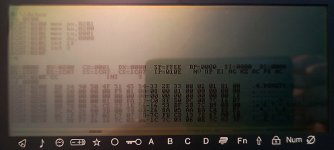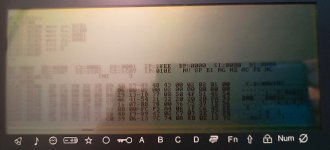1ST1
Veteran Member
Hello, any experts here, which know the usage of The Poquet PC?
That's a MS-DOS 3.30 based palmtop, introduced in the beginning of the year 1989, so even a bit older than the well known Atari Portfolio and much older than the HP 200LX. The Poquet is quite rare, but I got a working one. Like the Portfolio and the 200LX it's a pocket size MS-DOS mini laptop, in comparison with the Portfolio and the 200LX it is bigger, but it has a well and comfortable keyboard and 80x25 display. It's running on MS-DOS 3.30 and it has similar built in applications like the Portfolio (a spreadsheet is missing, but you can run original Lotus 1-2-3 or Microsoft Multiplan on it.)
I got it with a 64 kB and a 2 MB PCMCIA SRAM card (using CR2325 batteries) with the Poqet PC logo, so they are the original ones. After getting these batteries I was able to format the 64kB card and it holds it's content over power off and unplug and replug the card. I can't format the 2 MB card in the Poquet PC, it always says error in formatting.
So I found this website: https://www.bmason.com/PoqetPC/software/index.html
There is a software which is able to format that 2 MB card, but as I don't have anything else, means no serial/parallel cable for the Poqet I currently don't have any possibility to transfer the software to it.
So I thought beeing smart and pulling out my HP 200LX. First thing I tryied, I checked it's 10 MB Flash card, it's still formatted and there are datas on it. So I plugged that flash card in the b: drive of the Poqet, but it can't read that. So I plugged the 2 MB SRAM card into the HP 200LX and it was able to format it with 2 MB capacity. I plugged it back into the Poqet, but read error there. In the HP it is still readable, so not broken.
The point is, the 64kB card formatted in the Poqet PC is also fully readable in the HP 200LX.
Any explanation for that? Would it help to pull out one of my older Thinkpads with PCMCIA slot and Windows XP?
Would such a device help? I think they might be incompatible to such old PCMCIA memory cards? They may only support newer ATA cards. But that would be the easiest to just plug them to my Windows 11 notebook.


That's a MS-DOS 3.30 based palmtop, introduced in the beginning of the year 1989, so even a bit older than the well known Atari Portfolio and much older than the HP 200LX. The Poquet is quite rare, but I got a working one. Like the Portfolio and the 200LX it's a pocket size MS-DOS mini laptop, in comparison with the Portfolio and the 200LX it is bigger, but it has a well and comfortable keyboard and 80x25 display. It's running on MS-DOS 3.30 and it has similar built in applications like the Portfolio (a spreadsheet is missing, but you can run original Lotus 1-2-3 or Microsoft Multiplan on it.)
I got it with a 64 kB and a 2 MB PCMCIA SRAM card (using CR2325 batteries) with the Poqet PC logo, so they are the original ones. After getting these batteries I was able to format the 64kB card and it holds it's content over power off and unplug and replug the card. I can't format the 2 MB card in the Poquet PC, it always says error in formatting.
So I found this website: https://www.bmason.com/PoqetPC/software/index.html
There is a software which is able to format that 2 MB card, but as I don't have anything else, means no serial/parallel cable for the Poqet I currently don't have any possibility to transfer the software to it.
So I thought beeing smart and pulling out my HP 200LX. First thing I tryied, I checked it's 10 MB Flash card, it's still formatted and there are datas on it. So I plugged that flash card in the b: drive of the Poqet, but it can't read that. So I plugged the 2 MB SRAM card into the HP 200LX and it was able to format it with 2 MB capacity. I plugged it back into the Poqet, but read error there. In the HP it is still readable, so not broken.
The point is, the 64kB card formatted in the Poqet PC is also fully readable in the HP 200LX.
Any explanation for that? Would it help to pull out one of my older Thinkpads with PCMCIA slot and Windows XP?
Would such a device help? I think they might be incompatible to such old PCMCIA memory cards? They may only support newer ATA cards. But that would be the easiest to just plug them to my Windows 11 notebook.

USB 2.0 PCMCIA Card Reader Adapter Converter for 68 Pin Laptop Slots | eBay
Product: USB 2.0 to 68 PCMCIA Reader Adapter Converter. Supports PCMCIA, PC card ATA, ATA flash storage. Equipped with PCMCIA connector such as MS, XD, SM. Firefighter Glove Strap | Turnout Gear Work Glove Holder | Heavy Duty Buckle.
www.ebay.com

USB 2.0 to PC ATA PCMCIA Adapter Flash Disk Memory Card Reader Plug & Play NEW | eBay
The latest USB 2.0 interface, ATA card, FLASH DISK, card reader. This card reader has been already tested that no compatibility problems with ATA card, PC card and FLASH DISK card. Cards with ATA typeface are mostly readable.
www.ebay.com
Last edited:


